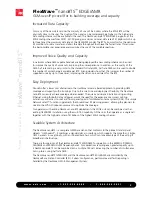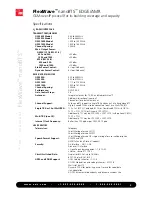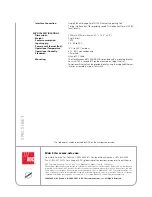
9/08
•
104624AE
FlexW
ave
™
nanoBTS
™
FlexWave
™
nanoBTS
™
EDGE/AMR
GSM-over-IP picocell for in-building coverage and capacity
2
w w w . a d c . c o m
•
+ 1 - 9 5 2 - 9 3 8 - 8 0 8 0
•
1 - 8 0 0 - 3 6 6 - 3 8 9 1
Increased Data Capacity
For many of the new data services the majority of use will be indoors where the EDGE BTS will be
physically close to the user. The quality of the signal can be correspondingly higher, so the higher rate
data coding schemes will be available to the user. The FlexWave nanoBTS EDGE/AMR supports all the
EDGE coding schemes from MCS1- MCS9 giving a maximum nominal data rate of 414kpbs which is up
to three times the maximum data rate of the GSM/GPRS model. The BTS also monitors for the optimum
RF conditions for data transfer and alters the data throughput to achieve the fastest rates This ensures
the best possible user experience and maximizes the use of the available spectrum.
Improved Voice Quality and Capacity
In networks where AMR capable handsets are being deployed the new coding scheme can be used
to improve the quality of voice calls, improving the user experience. In addition, as the quality of the
AMR half rate coding is very similar to the standard full rate GSM, half rate AMR can be used to double
the number of voice channels available per BTS. Erlang models show that this increases the number of
supported users by up to three times, improving the return on investment for the BTS.
Easy Deployment
Picocells offer a lower cost alternative to the traditional antenna based approach to providing GSM
coverage and capacity within buildings. Due to the small size and deployment flexibility, the FlexWave
nanoBTS can easily achieve coverage where needed. The quick and simple installation using existing
Ethernet wiring for both data and power avoids the need for the expensive site surveys, cabling
installations and access to roof and floor spaces typical of distributed antenna systems (DAS). The unique
Network Listen™ function supplements the conventional RF planning process, allowing the planners to
see into the difficult indoor environment to optimize the coverage.
For operators with existing FlexWave nanoBTS deployments the EDGE unit can be combined with an
existing GSM/GPRS installation using the multi TRX capability. All the units then operate as a single cell
together with the high data rates of 414kbps of the highest EDGE coding schemes.
Scalable System Architecture
The FlexWave nanoBTS is a complete GSM base station that conforms to the picocell standard and
delivers “GSM-over-IP”. It combines a standard Um air interface, which supports the more than 2 billion
GSM handsets in use globally, with an IP based backhaul, which can take advantage of the existing IP
broadband infrastructure.
There are four versions of the FlexWave nanoBTS EDGE/AMR for operation in the 850MHz, 900MHz,
1800MHz and1900MHz GSM frequency bands. For applications requiring even greater capacity up to
4 FlexWave nanoBTS can be combined into a multiple TRX cell, increasing the number of simultaneous
calls up to 62 using half rate AMR.
The FlexWave nanoBTS GPRS/GSM and the FlexWave nanoBTS EDGE/AMR are controlled by the
FlexWave Base Station Controller (BSC). System configuration, performance and fault reporting is
handled by the FlexWave OMC-R Management System.






















